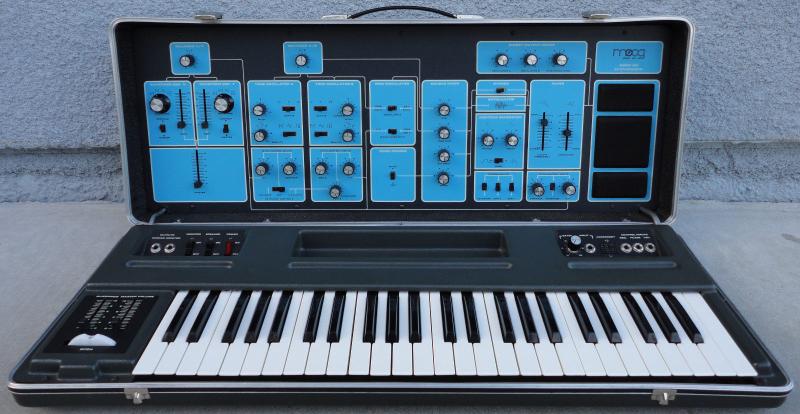Filter on ALL, SYNTH, DRUM, SAMPLER or MISC |
Total list currently 2405 items in 330 Brands |
Moog muSonics | Sonic Six |
Description | The Moog Sonic Six is a duophonic analog synthesizer that was manufactured by Moog Music from 1972 to 1979. It's portability was used for lectures and educational purposes Bob Moog. The Sonic Six is the result of owner Bill Waytena of synthesizer maker Musonics which bought R.A. Moog Inc. as the company name Moog went under in this period. By using the Moog name, Waytena bought R.A. Moog Inc.,and moved the company to Buffalo, New York, and renamed it Moog/Musonics. The instrument is a duophonic 2 vco with interesting LFO features as well as an option for setting one oscillator to drone mode while the other tracks the keys. The Sonic Six is an interesting, although obscure synthesizer from the Moog history books. Its predecessor, the Sonic V, was designed by an ex-Moog employee for the muSonics brand. When muSonics eventually bought out R.A. Moog, forming Moog muSonics, the Sonic V’s basic design was moved into a portable brief-case style synthesizer, and with only a few tweaks, the Sonic Six was born. The fact that the Sonic Six originated from another company’s design not only accounts for why the Sonic Six looks different than any other Moog, but also for some pretty unique differences under the hood as well. To start, it is duo-phonic, utilizing two analog oscillators with three basic waveforms each plus tuning, modulation and scaling controls. There are two independent LFO generators with advanced control options not seen on other Moog synths (for instance, an X/Y knob is used to mix and balance the LFO outputs). Also on-board is a Ring Modulator (that can modulate either Osc. B or external audio) and pink/white noise generators. Moog synthesizers are known for their filters, and the Sonic Six strays from the usual Moog in this area as well. While it is known that ARP stole a filter design from Moog for use in some of their 2600 and Odyssey models, leading to lawsuits between Moog and ARP, according to Mark Vail in "Vintage Synthesizers," the Sonic Six actually used some circuitry in its filters which were stolen from an ARP design, although ARP never sued Moog over it. However, later models of the Sonic Six were eventually fitted with a more traditional Moog designed filter. In either case, the filter is a low-pass 24dB/oct which offers the usual controls and is capable of self-oscillation. The VCA, however, has a rather limited set of controls - attack and decay plus a sustain on/off switch. Not commonly seen, they are actually rather durable devices and used ones generally (if proper care was taken of them) are found in good working order. It was originally designed for educational and home use so it is light and portable and even has a built-in amplifier and speaker. It’s a genuine Moog synth that is equally as obscure as useful these days. And its rather simple looking front-panel layout hides the uniquely flexible, powerful and great sounding little beast it truly is! |
| Brand | Moog muSonics |
| Model | Sonic Six |
| Device | Synth |
| Type | Keys |
| Engine Type | Analog |
| Engine | VCO |
| Voices (max) | 2 |
| Oscillators | 2 |
| LFO | 2 multimode LFO's with variable rate (sawtooth, ramp, triangle and square) |
| Engine Detailed | 2 VCO's with sawtooth, triangle, pulse waveforms (variable pulse width on Osc B only) |
| Filter (VCF) | 1 24dB/oct low pass filter |
| Envelope (VCA) | Attack / Decay / Sustain or Release |
| Keys | 49 |
| Key type | Keys |
| Velocity | No |
| Aftertouch | No |
| CV-gate | CV/GATE |
| Produced: | 1972 - 1979 |
| Legend: | Obvious | Y: Yes, N: No, N/A: Not Applicable | |
| VCO | Voltage Controlled Oscillator | DCO | Digital Controlled Oscillator |
| LFO | Low Frequency Oscillator | Sub | Sub Oscillator |
| VCF | Voltage Controlled Filter | VCA | Voltage Controlled Amplifier |
| Velocity | As with a piano, the harder you hit a key, the louder the sound, unlike most organs which always produce the same loudness no matter how hard you hit a key. | Aftertouch | Pressing a key after you activated it. Channel Aftertouch, no matter which key, it will send a Channel message. Poly Aftertouch, sends the pressure per key instead of the whole channel. |
| Values for OSC, LFO, Filter, Envelope are per voice unless stated otherwise. | |||



